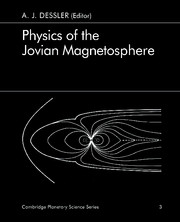Book contents
- Frontmatter
- Contents
- List of tables
- List of contributors
- Foreword
- Preface
- 1 Jupiter's magnetic field and magnetosphere
- 2 Ionosphere
- 3 The low-energy plasma in the Jovian magnetosphere
- 4 Low-energy particle population
- 5 High-energy particles
- 6 Spectrophotometric studies of the Io torus
- 7 Phenomenology of magnetospheric radio emissions
- 8 Plasma waves in the Jovian magnetosphere
- 9 Theories of radio emissions and plasma waves
- 10 Magnetospheric models
- 11 Plasma distribution and flow
- 12 Microscopic plasma processes in the Jovian magnetosphere
- Appendix A Symbols and acronyms
- Appendix B Coordinate systems
- Appendix C Jupiter and Io: selected physical parameters
- References
- Index
7 - Phenomenology of magnetospheric radio emissions
Published online by Cambridge University Press: 27 October 2009
- Frontmatter
- Contents
- List of tables
- List of contributors
- Foreword
- Preface
- 1 Jupiter's magnetic field and magnetosphere
- 2 Ionosphere
- 3 The low-energy plasma in the Jovian magnetosphere
- 4 Low-energy particle population
- 5 High-energy particles
- 6 Spectrophotometric studies of the Io torus
- 7 Phenomenology of magnetospheric radio emissions
- 8 Plasma waves in the Jovian magnetosphere
- 9 Theories of radio emissions and plasma waves
- 10 Magnetospheric models
- 11 Plasma distribution and flow
- 12 Microscopic plasma processes in the Jovian magnetosphere
- Appendix A Symbols and acronyms
- Appendix B Coordinate systems
- Appendix C Jupiter and Io: selected physical parameters
- References
- Index
Summary
The radio spectrum of Jupiter spanning the frequency range from below 10 kHz to above 3 GHz is dominated by strong nonthermal radiation generated in the planet's inner magnetosphere and probably upper ionosphere. At frequencies above about 100 MHz, a continuous component of emission is generated by synchrotron radiation from trapped electrons between equatorial distances of about 1.3 and 3 Rj. This component exhibits a broad spectral peak at decimetric (DIM) wavelengths, distinct longitudinal asymmetries arising from asymmetries in Jupiter's magnetic field, and slow intensity variations that are presumably related to temporal changes in the energy, pitch angle, or spatial distributions of the radiating electrons. High resolution mapping of this component will probably continue to provide detailed information on the inner magnetosphere structure that is presently unobtainable by other means. Jupiter's most intense radio emissions occur in the frequency range between a few tenths of a MHz and 39.5 MHz. This decameter-wavelength (DAM) component is characterized by complex, highly organized structure in the frequency-time domain and by a strong dependence on the longitude of the observer and in some cases, of Io. The DAM component is thought to be generated near the electron cyclotron frequency in and above the ionosphere on magnetic field lines that thread the Io plasma torus, but neither the specific location(s) of the radio source(s) nor the specific plasma emission process are firmly established. At frequencies below about 1 MHz there exist two independent components of emission that have spectral peaks at kilometer (KOM) wavelengths. One is bursty, relatively broadbanded (typically covering 10 to 1000 kHz), and strongly modulated by planetary rotation.
- Type
- Chapter
- Information
- Physics of the Jovian Magnetosphere , pp. 226 - 284Publisher: Cambridge University PressPrint publication year: 1983
- 196
- Cited by



